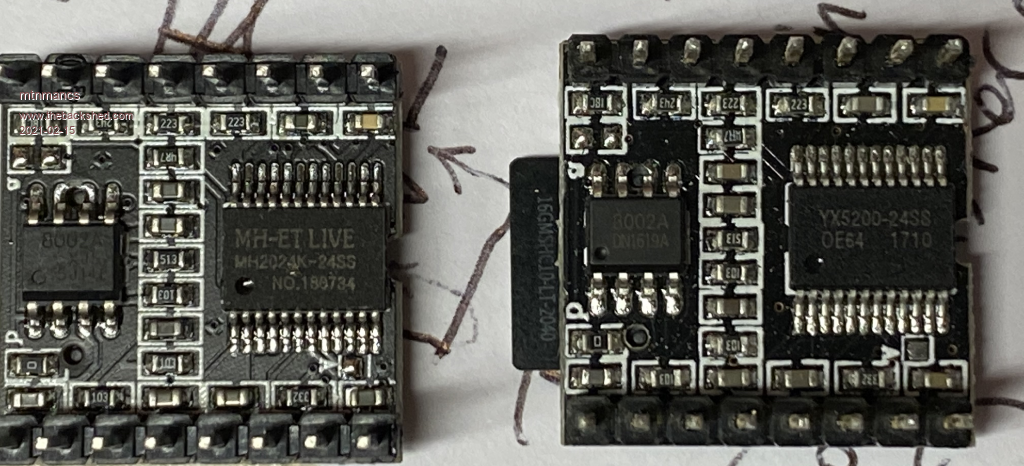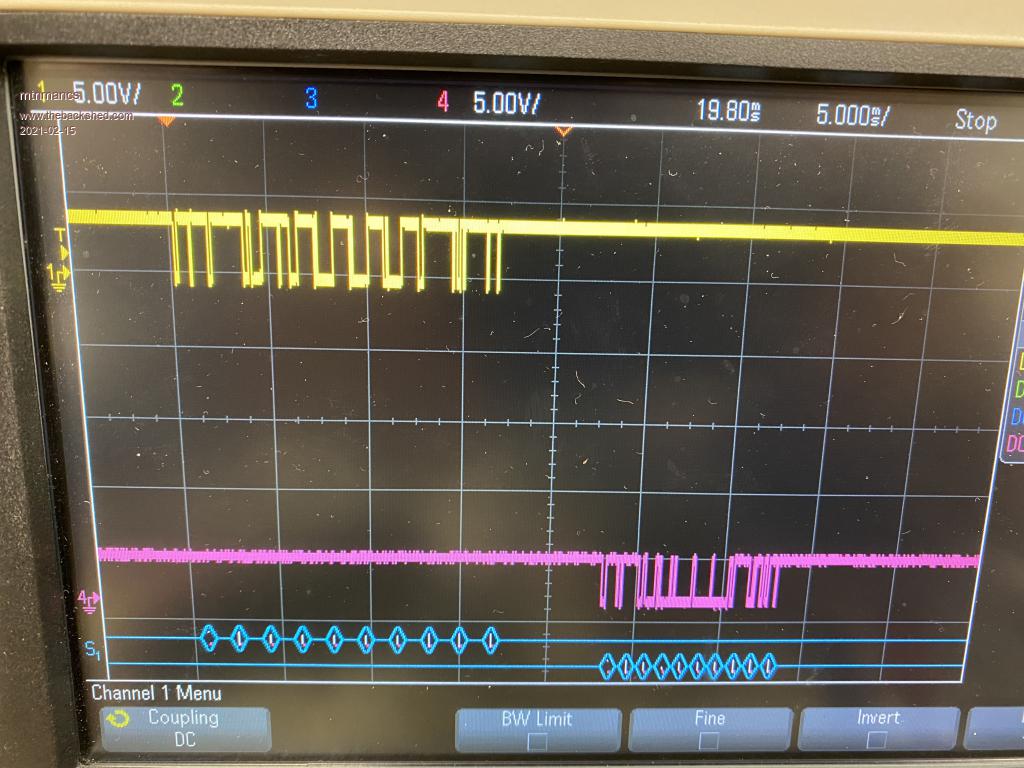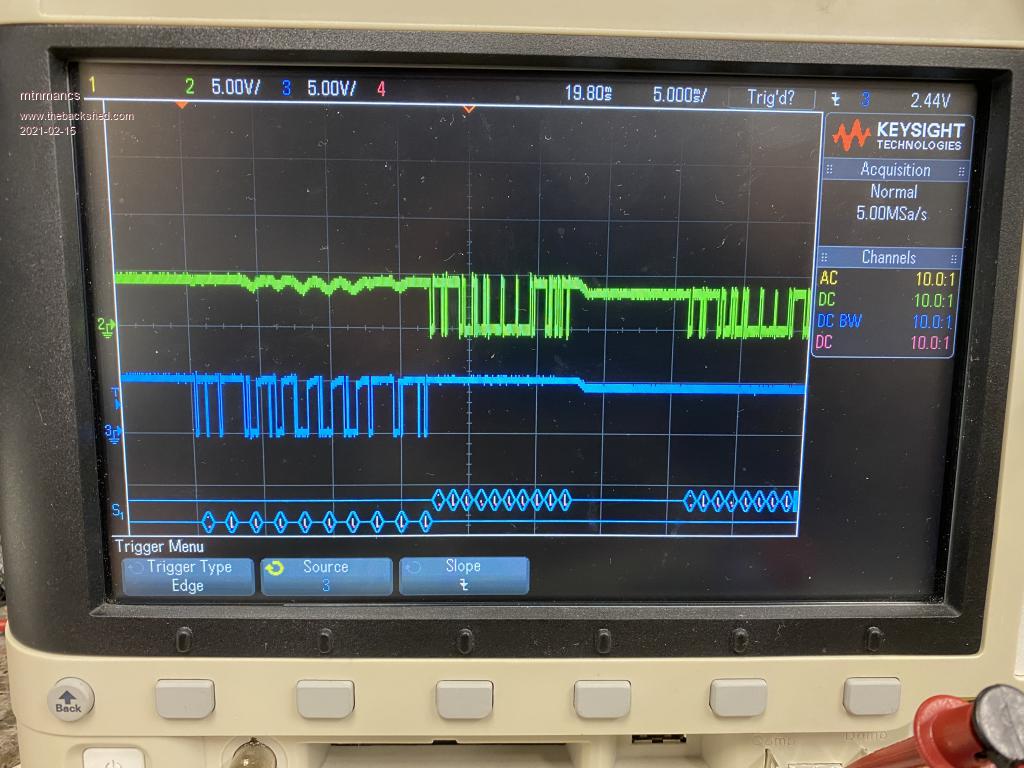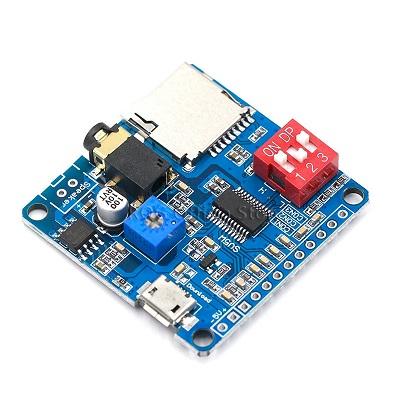
|

|
Forum Index : Microcontroller and PC projects : DFPlayer Mini v MP3-TF-16P
| Author | Message | ||||
| mtnmancs Newbie Joined: 13/02/2021 Location: United StatesPosts: 5 |
Hi Gerry, that's really helpful to know! I will definitely give that a try! Thank you for sharing this helpful tip. |
||||
Grogster Admin Group Joined: 31/12/2012 Location: New ZealandPosts: 9308 |
Can you please confirm that is NOT a typo. None of us were able to get the 2024's to respond in any way to the standard serial commands. The 3024 chip did, but the 2024 did not and appeared to be button-only type of control. I was using a Micromite with 3v3 I/O, so no series resistor at all on either of the UART pins. I just want to make sure that I am reading your post correctly with respect to that variant, cos if I am, then that is really strange cos in theory, the 2024 should NOT have worked for you via serial.  Oh, and welcome aboard, BTW.  Smoke makes things work. When the smoke gets out, it stops! |
||||
| mtnmancs Newbie Joined: 13/02/2021 Location: United StatesPosts: 5 |
Hi Grogster, Yes, I can confirm that this is not a typo! I will upload some pictures to help demonstrate that I am successfully using a module with an IC marked MH2024K. First, I'll upload a picture of the module that I'm using. On the left, you can see the module with MH-ET LIVE, MH2024K-24SS. On the right, you can see the module with YX5200. I am able to get both of these modules to work, but with the MH2024K I have to short out the series resistor that I have in the serial line from my PIC16 to the RX pin on the module.  Now for some scope traces: First, here is TX and RX on my YX5200 module. Input to the module is obviously channel 1 (yellow) and output from the module is obviously channel 4 (pink). Sorry about the dust on my scope screen! Note that the output swings about 3.3V with nice clean transitions. You can see my serial decode at the bottom of the screen, although I haven't zoomed in enough for you to see the bytes. The point is simply that the scope's serial decode is properly decoding the bytes at 9600 baud.  Next, here is TX and RX on an MH2024K module. Input to the module is channel 3 (blue) and output from the module is channel 2 (green). Note that the output sometimes swings 5V (for the first packet) and sometimes 3.3V (for the second packet). Also note the coupling from RX to TX during the time when I am transmitting to the module. Also note that the transitions are not as clean (on both TX and RX). It's pretty clear to me that this module's IO isn't really designed to work with a 5V supply. Note that serial decode on the scope is still working fine.  So, both of these modules work (I can get both to play tracks), but the MH2024K certainly doesn't look as clean from a serial comms standpoint, and it is also noisier from an audio standpoint as I mentioned in my post a few days ago. The audio noise is annoying, so I'm going to dig into that more. I hope all of this is helpful to everyone! |
||||
| mtnmancs Newbie Joined: 13/02/2021 Location: United StatesPosts: 5 |
I made a discovery today that I thought you all might be interested in. I reported a few days ago about quite a few different modules, including modules with a chip labeled GD3200B. I mentioned that this part has 16 pins instead of 24 (which the YX5200 has). I also stated that, "The module does not respond at all to serial communications." Today, I was making a video to help me dispute my latest purchase of modules from Alibaba, and in the process of making the video I discovered that these modules do indeed respond to serial, and they do actually play my recordings. I suspect that when I tested the GD3200B modules the other day, I still had the series resistor in the RX line. I'm going to include a photo of the module with scope traces in the background. If you're very astute, you'll notice that I didn't have an SD card in the module when I took the picture, but I promise that the module plays sound from my SD card (I was inserting and removing the SD card for a reason that I'll explain below). You'll also notice that I focused my camera on the module so that you could see it (and I apologize that the scope screen is a bit blurry as a result). .jpeg) Here is second photo in which I put my finger under the module so that you can see that it's orange indicator LED is illuminated: .jpeg) I mentioned yesterday that I'm annoyed by noise in the audio. The "GD3200B" modules have a different noise problem than I observed on the MH-ET LIV MH2024K and the JC AA20HF modules. A few days ago, I mentioned that the MH2024K and the JC AA20HF exhibit, "high-frequency digital noise on some tracks, always toward the beginning of the recording (for the first 5 seconds of a 10-second recording, for example). The noise sounds like mid-band glitching, followed by bursts of low-frequency noise." I observed the same behavior today on the MH2024K and JC modules, but I also found that the GD3200B modules do not exhibit such noise. However, I also discovered that the GD3200B do exhibit a constant "whine" on top of white noise. I'm a bit surprised that the noise is below the noise floor of my scope, but in my headphones it sounds like it might have a fundamental at about 1kHz. The noise is louder with the SD card out, and produces a certain pattern when I insert the SD card (high frequency glitch sound, followed by noise with a certain harmonic content, followed by noise with the same fundamental but different harmonic content). I'm sorry that I don't have a good FFT to show you! And by the way, I'm doing the noise testing with the modules plugged into a test board with good close bypass (not hanging in the air in front of my scope). I'll continue to study this problem and let you know what I learn. If anyone has thoughts, feel free to share! |
||||
Grogster Admin Group Joined: 31/12/2012 Location: New ZealandPosts: 9308 |
Very interesting!   It would seem we were wrong. Nice work. I wonder why most of us who played with the 2024, could not get them to respond to serial commands?  Smoke makes things work. When the smoke gets out, it stops! |
||||
| mtnmancs Newbie Joined: 13/02/2021 Location: United StatesPosts: 5 |
  It would seem we were wrong. Nice work. I wonder why most of us who played with the 2024, could not get them to respond to serial commands?  Have any of you tried operating the 2024 with a 5V supply and 5V serial? If not, would anyone be willing to go back and try this and let us know if it works for you as well? If you're using a 3.3V microcontroller, and you need a level translator, you could make a simple one with two transistors and four resistors: TwoTransistorsFormBidirectionalLevelTranslators.pdf |
||||
| Amberwolf Newbie Joined: 01/06/2023 Location: United StatesPosts: 1 |
Apologies for waking this thread from it's long nap, but I have a question whose answer has eluded me: This forum has had the most useful info and experimentation with these boards that I found in one place; thank y'all for that. :) But one thing I couldn't find anywhere (probably due to language barriers / translations with manuals, etc) is whether or not this board has a mode using just buttons (no external MCU) to keep looping a sound. If it's helpful, this is the reasoning / project info: I have a project that will all fit inside an old small computer speaker enclosure with a tiny 5v-powered amp and one of the various small sound boards. I was using an SV5W  but it got tired and couldn't hold the smoke in anymore. It's also a little big for the space available (it fits, but not easily). I have some more on order, along with a few other kinds of similar boards.... All it has to do is at power on just continuously loop playback of a long sound file. Which file is played is determined by which switch is turned on; this can be changed during playback to a different one by turning on a different switch (turning off the first one). (a rotary switch would work better but there isn't room inside for that). So...I have been looking at the DFPlayer and other boards (JQ6500, etc) that can be operated by just buttons, but they don't all specify that they have a loop mode...which may mean they don't, but could just be a failure to document it. The JQ6500 has a mode using the ADKey inputs and a specific resistor value to set a mode to playback looping a file continuously. I couldn't find if the DFplayer can do this. So...if y'all know if it can or can't, or of any other SD/TF-card-capable tiny sound player boards that can loop a sound via just buttons, I'd appreciate if you could point me in their direction. I know I could do all this with an MCU and code, and I have some Nanos I could use to control it with, but I'm still far from being able to code anything to do this, and would really rather just playback via buttons for this part of the project. Hardware, I'm good with. Software, well, I haven't coded anything since the 1980s and only really remember the general concepts.... Eventually, I'll need to use an MCU to interpret a bunch of touch sensor inputs for what output to make, but that's in the future, once I figure out how to make them work for larger, overlapping areas (using wire antennas). Edited 2023-06-04 12:28 by Amberwolf My SB Cruiser trike https://endless-sphere.com/sphere/threads/the-sb-cruiser-amberwolfs-2wd-heavy-cargo-trike-dog-carrier.67833/ My music: http://amberwolf.bandcamp.com |
||||
Grogster Admin Group Joined: 31/12/2012 Location: New ZealandPosts: 9308 |
Hello.  Yes, according to the manual for the 5200 chip, but it uses two ADC channels to allow for up to 20 buttons. They are all tripped by pulling a certain point in the chain low, and the ADC is referenced to 3v3, so it is directly compatible with the likes of the PicoMite. Hold the point in the chain low with an I/O pin, and the file will play on repeat till you release the line. Do you have the ENGLISH version of the 5200 decoder chip PDF? If not, I can upload it here. If you can also provide a link to the module you are trying to use, that would help, as the photo does not tell us what pins are being routed out to the edge of the board. Smoke makes things work. When the smoke gets out, it stops! |
||||